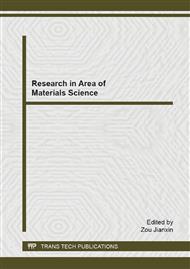[1]
Emre Sefer, Fatma Baycan Koyuncu, Eda Oguzhan, A new near-infrared switchable electrochromic polymer and its device application, Journal of Polymer Science 48 (2010) 4419-4427.
DOI: 10.1002/pola.24229
Google Scholar
[2]
L. D. Aubrey, R. C. Michael, E. B. Joseph, Orange and red to transmissive electrochromic polymers based on electron-rich dioxythiophenes, Macromolecules 43 (2010) 4460-4467.
DOI: 10.1021/ma100366y
Google Scholar
[3]
H. J. Shin, Y. N. Kim, T. Bhuvana, Color combination of conductive polymers for black electrochromism, Applied Material Interfaces 4 (2012) 185-191.
DOI: 10.1021/am201229k
Google Scholar
[4]
A. Q. Zhang, Y. Zhang, L. Zh. Wang, Electrosynthesis and capacitive performance of polyaniline-polypyrrole composite, Polymer Composites (2011) 1-4.
Google Scholar
[5]
Ch. H. Yang, Y. Ch. Lo, P. L. Huang, Enhancing the performance of poly(3-methylthiophene) -based electrochromic devices via insertion of a TiO2 buffer layer, Journal of Electroanalytical Chemistry 661 (2011) 113-119.
DOI: 10.1016/j.jelechem.2011.07.023
Google Scholar
[6]
S. F. Hong, L. Ch. Chen. A red-to-gray poly(3-methylthiophene) electrochromic device using a zinc hexacyanoferrate/PEDOT: PSS composite counter electrode, Electrochimica Acta, 55 (2010) 3966-3973.
DOI: 10.1016/j.electacta.2010.02.033
Google Scholar
[7]
J. Qian, Zh. Y. Fu, X. Li, Research progress of electrochromic devices based on conducting polymers, Chemical Research and Application. 20 (2008) 1397-1404.
Google Scholar
[8]
M. Fabretto, J. P. Autere, D. Hoglinger, Vacuum vapour phase polymerised poly(3, 4- ethyelendioxythiophene) thin films for use in large-scale electrochromic devices, Thin Solid Films 519 (2011) 2544-2549.
DOI: 10.1016/j.tsf.2010.12.016
Google Scholar
[9]
X. F. Ma, F. Li, Conductive Ink Technology and Research Direction, China Printing And Packaging Study 6 (2010) 9-14.
Google Scholar
[10]
C. Giacoponello, H. Lindstrom, Electrochromics: unlocking color in electronic paper, Advanced Display 90(2008) 16-18.
Google Scholar
[11]
A. L. Dyer, E. J. Thompson, J. R. Reynolds, Completing the color palette with spray- processable polymer electrochromics, Appled Materal Interfaces 3 (2011) 1787-1795.
DOI: 10.1021/am200040p
Google Scholar
[12]
H. Wang, X. Z. Liu, H. C. Wu, Study on the properties of organic dye sensitized polyaniline by electrochemical polymerization, Journal of Xi'an Jiaotong University 33 (1999) 19-22.
Google Scholar
[13]
Y. J. Tao, H. F. Cheng, W. W. Zheng, Electrosynthesises and characterizations of copolymers based on pyrrole and 3, 4-ethylenedioxythiophene in aqueous micellar solution, Synthetic Metals 162 (2012) 728-734.
DOI: 10.1016/j.synthmet.2012.02.003
Google Scholar
[14]
P. M. Beaujuge, J. R. Reynolds. Color control in π-conjugated organic polymers for use in electrochromic devices, Chemical Reviews 110 (2010) 268-320.
DOI: 10.1021/cr900129a
Google Scholar


